Published
on 19
Apr 2018
|
All rights reserved.
|
|
|
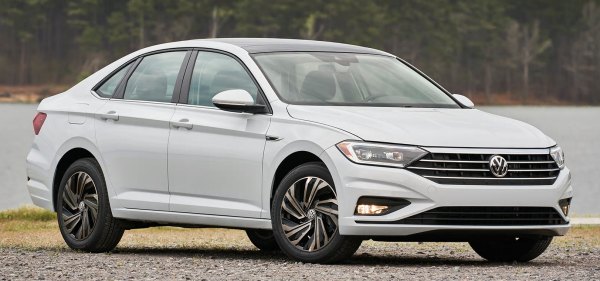
|
|
Still
targets at the mainstream, but the new Jetta cuts costs without making
you feel it.
|
|
Few people love the last
generation Volkswagen Jetta. In an attempt to compete with Toyota
Corolla, Honda Civic etc. in the USA market, Volkswagen decided to
abandon its semi-premium image and trim costs as much as possible. It
was given a dull packaging, a lot of low-rent plastics, a cheap rear
suspension and an outdated 8-valve engine. Fans of VW were shocked and
disappointed. The cheaper car lured more buyers from the mainstream
crowd,
but not more enough to threaten its Japanese rivals. Moreover, it
damaged the reputation of the German brand.
Even though multi-link suspension and TSI engines were introduced
afterwards, it was too late.
Wise people learn from mistakes. This time around, the 7th generation
Jetta has corrected many faults of its predecessor. Not that it
abandons the mainstream positioning. No, the new car still targets at
the same buyers of Corolla and Civic thus it is deemed to be half a
notch lower than Golf. In the US market, it even marginally undercuts
the old car model by model. However, this time it manages to cut costs
without making you feel it. This is very important.
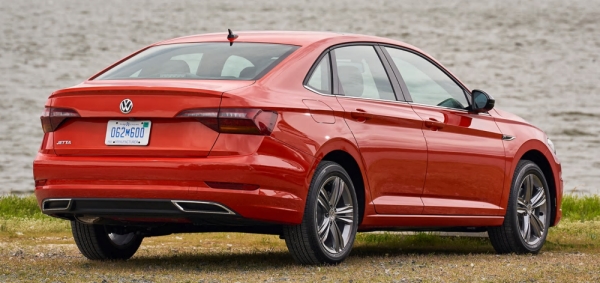
|
|
From
B-pillar rearward it looks remarkably like an Audi A3 sedan.
|
|
The new Jetta might not be a piece of art. Its front end design is
particularly dull. The wide hexagonal grille has little aesthetic to
speak of, nor it has any family resemblance to other Volkswagens –
isn’t hexagonal grille a signature of Audi? I don’t understand why it
was designed that way. However, front end aside, the car looks pretty
good. Its body profile is sleeker, the waist line is lower and crisper.
From B-pillar rearward it even looks remarkably like an Audi A3 sedan.
Jewel-like head and tail-lights add to the sense of sophistication.
Drag coefficient is also improved from 0.30 to 0.27.
The new car is slightly longer and wider than before, while its
wheelbase is stretched by 35mm to 2685mm. Nevertheless, the latter does
not reflect in rear legroom, as it is actually reduced by 18mm. The
cabin does afford slightly more headroom and shoulder room for both
rows. Get inside, you will find it still offer competitive space for
the class. 4 six-footers can be squeezed inside without much complaint,
although they will be happier to squeeze inside a Civic. What really
lifted the new Jetta above its predecessor is the design and build
quality of the interior. Its new dashboard is so much more stylish,
while there are a lot more soft-touch or better grained plastics –
though no match for Golf, predictably. The infotainment touch screen on
the
center console is angled slightly towards the driver for easier
reading. You can even opt for a TFT instrument called Digital Cockpit,
or Volkswagen’s version of Audi
Virtual Cockpit. Moreover, you won’t be disappointed with Volkswagen’s
infotainment system, as it is typically intuitive and responsive. The
base car offers cloth seats but they are supportive. Leather upholstery
is available on more expensive models. For quality perception and
technology, it has its Japanese rivals clearly beaten.
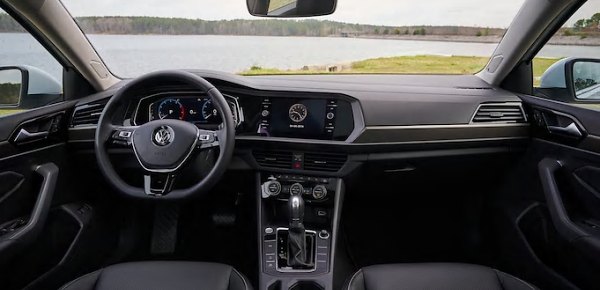
|
|
For quality
perception and technology, it has its Japanese rivals clearly beaten.
|
|
As the cabin is more expensive, some costs have to be trimmed
elsewhere. The new Jetta has its rear suspension reverted to cheap
torsion-beam axle. Disappointed? Not really, because it is now built on
the same MQB platform as Golf VII. Remember, the lower power models of
Golf employ also torsion-beam rear suspension, but we heard no
complaints. It goes without saying the problems of the old Jetta was
more about its older platform than its suspension. As long as you don’t
target at Ford Focus-level of sharp handling, a torsion-beam axle could
be up to the job, provided you have a good platform that is rigid and
light.
The MQB satisfies this requirement. On the Jetta, the suspension tuning
is softer than its siblings to deliver the kind of ride comfort that
American customers want. It is also mounted through hydraulic
bushings to reduce NVH. On the road, the car rides nicely in most
situations. Only really large bumps will catch it out and reveal its
lack of
fully independent suspension. Thanks to the solid chassis and good
insulation, high-speed cruising feels remarkably refined. Handling is
also very competent. Its dual-pinion steering guides the car
accurately. It corners with decent body control. At the limit, it runs
into understeer gently, but the predictable handling is exactly what
most family car buyers want. However, more demanding drivers will
prefer the tighter control and sharper turn-in of Focus, Golf, Mazda or
even Honda.
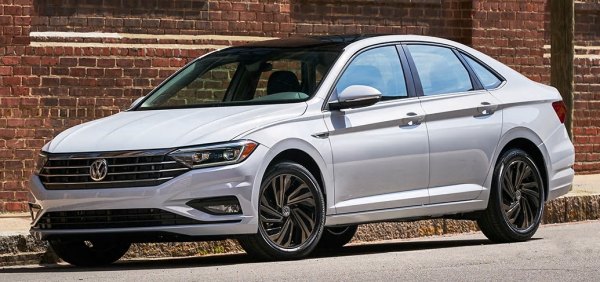 |
|
A torsion-beam
axle could be up to the job, provided you have a good platform, MQB.
|
|
Unexpectedly, only one engine is offered in the US market at launch.
The 1.4 TSI engine is carried over from the old car. It produces 147hp
and 184 lbft of torque, emphasizing on low-end torque (which peaks from
merely 1400 rpm) rather than high-end sparkles. This is a good
bread-and-butter engine that satisfies the need of everyday driving.
Mated with a new 8-speed automatic gearbox (no DSG this time) or
6-speed manual, the car delivers respectable fuel economy, decent
performance (expect 0-60 mph in about 8 seconds) and good refinement,
if lacking excitement. Honda’s 1.5 Turbo engine offers more power and
sportier sound, but Jetta will respond with a powerful 2.0 TSI engine
soon, hopefully under the badge of GLI. The 8-speed automatic works
smoothly and responsively, a better bet than Japanese CVTs. The manual
gearbox offers crisped gearshift and a linear clutch.
It might be too much to declare the Jetta back to form, but it is
certainly miles better than the last one. If it is given a more stylish
nose, an optional multi-link rear suspension and the choice of more
powerful engines, it might even threaten Golf. Cost control is still
very much a concern in its development. Fortunately, this time the
drawbacks are kept to the minimum. At the moment, the new Jetta is to
be
built and sold only in North America. Volkswagen should consider
introducing it to China and the rest of the world.
|
Verdict:     |
Published
on 22
May 2019
|
All rights reserved.
|
|
Jetta GLI
|
|
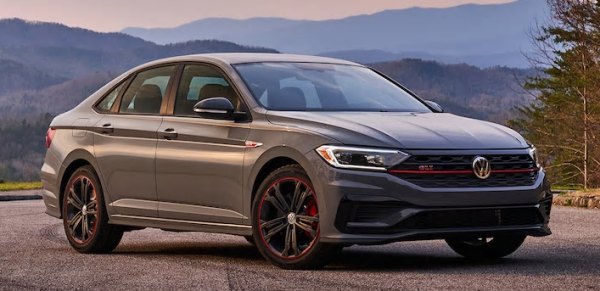
|
|
The
GLI goes way better than it looks.
|
|
Traditionally,
the hot version of VW Jetta is called GLI instead of GTI, but it takes
most mechanicals from the Golf GTI. The new Jetta GLI is no exception.
It employs the GTI's EA888 2-liter turbo engine with 228hp (SAE, or
230hp DIN) and 258 lbft of torque, accompanied with the same VAQ
electronic LSD, 6-speed manual or 7-speed DSG, adaptive dampers and,
most important, multi-link instead of torsion-beam rear axle on lesser
Jettas.
Although the Jetta outweighs the Golf by more than 100kg, it is still
plenty fast, doing 0-60 mph in 6 seconds. The power is flexible and
plenty. The manual gearshift and clutch take-up are excellent. The DSG
is as great as usual. The car also cruises with superb refinement, a
sign of quality product.
When it comes to handling and ride, it loses very little to its lighter
and shorter sibling. The steering remains well weighted, accurate and
responsive. The suspension, even without adaptive dampers fitted, copes
well with rough surfaces yet has body motions well controlled. It rolls
progressively and balances nicely. Easy to drive fast and slow. The
340mm front brakes, taken straight from Golf R, handles its extra
weight with ease. Like Golf GTI, this is not a top-tier, hardcore
driver’s car, but it hits the right balance between driving fun and
practicality/affordability.
And what an affordability – it costs less than the Golf GTI, yet it
offers more metal for the money. Remember, the Jetta has a longer
wheelbase hence a lot more rear legroom than the Golf. Its boot is also
a lot larger. You might not notice from the driver’s seat, but rear
passengers will feel the difference. How does Volkswagen managed to
offer more car for less buck? Look at the hard plastics on dash and
door panels, the cheaper cloth seats and instrument gauges and you’ll
see. The dull exterior and interior design also save a lot of man-hour.
A Golf GTI makes you a prouder owner. The Jetta GLI is still a good
car, just underrated by its cheaper packaging.
|
Verdict:     |
|